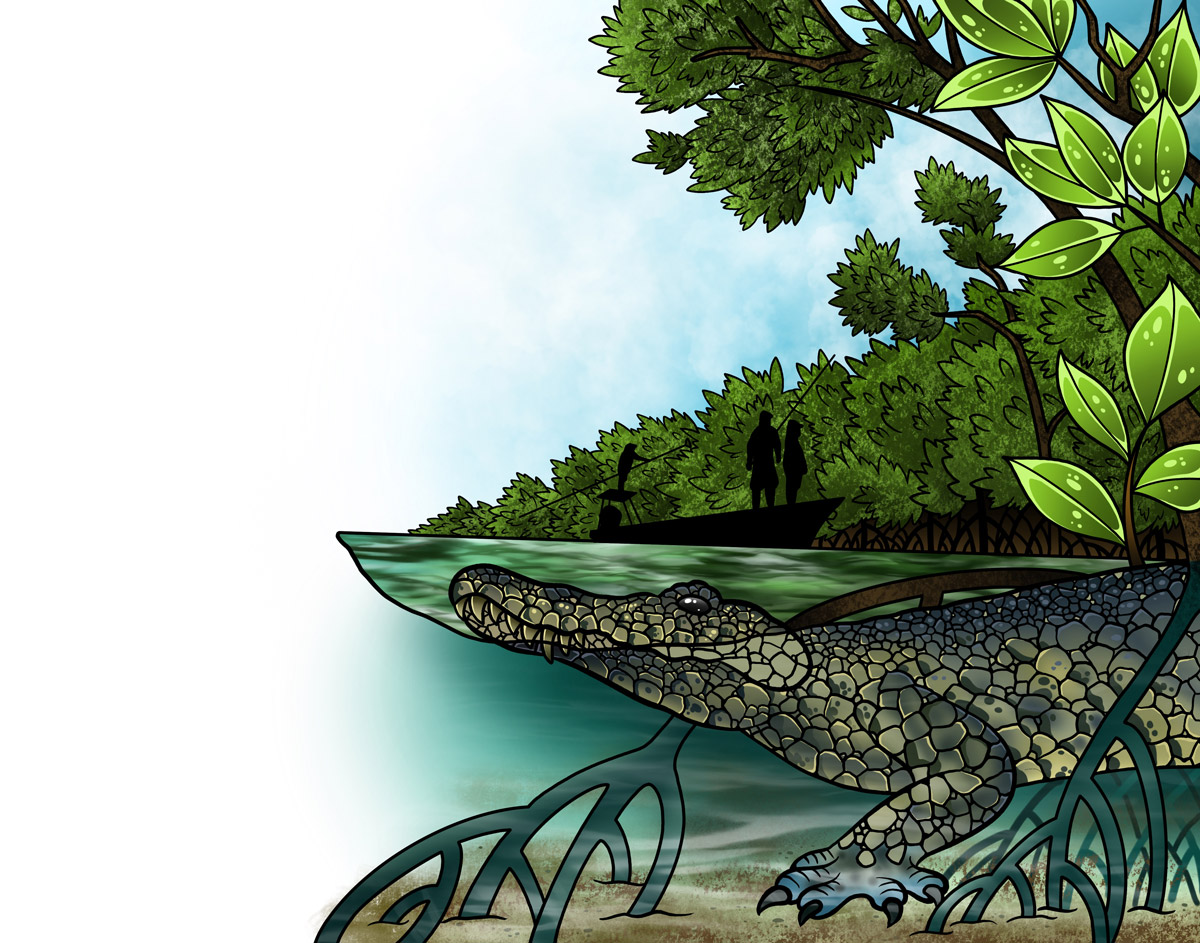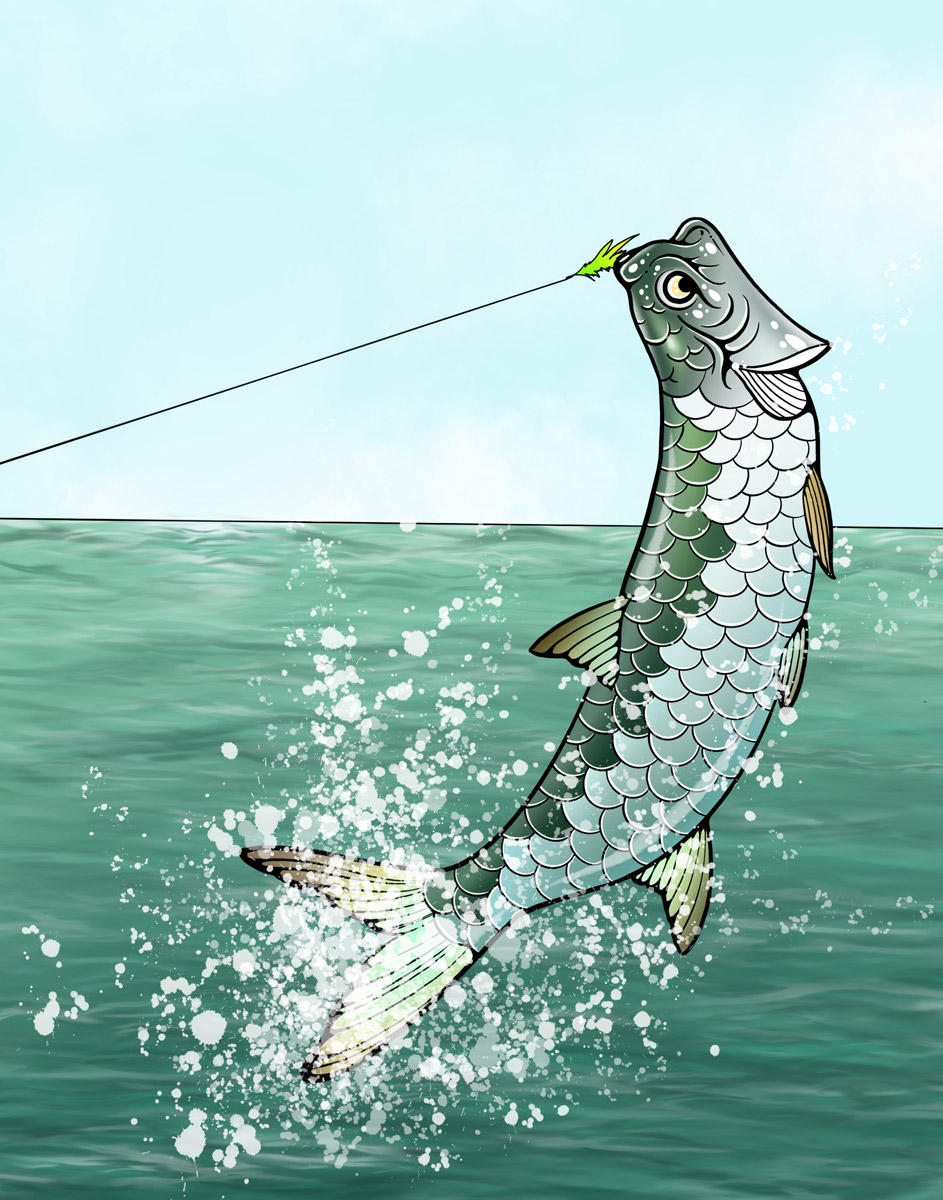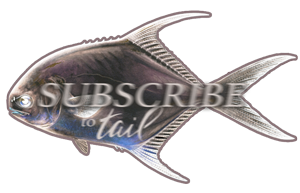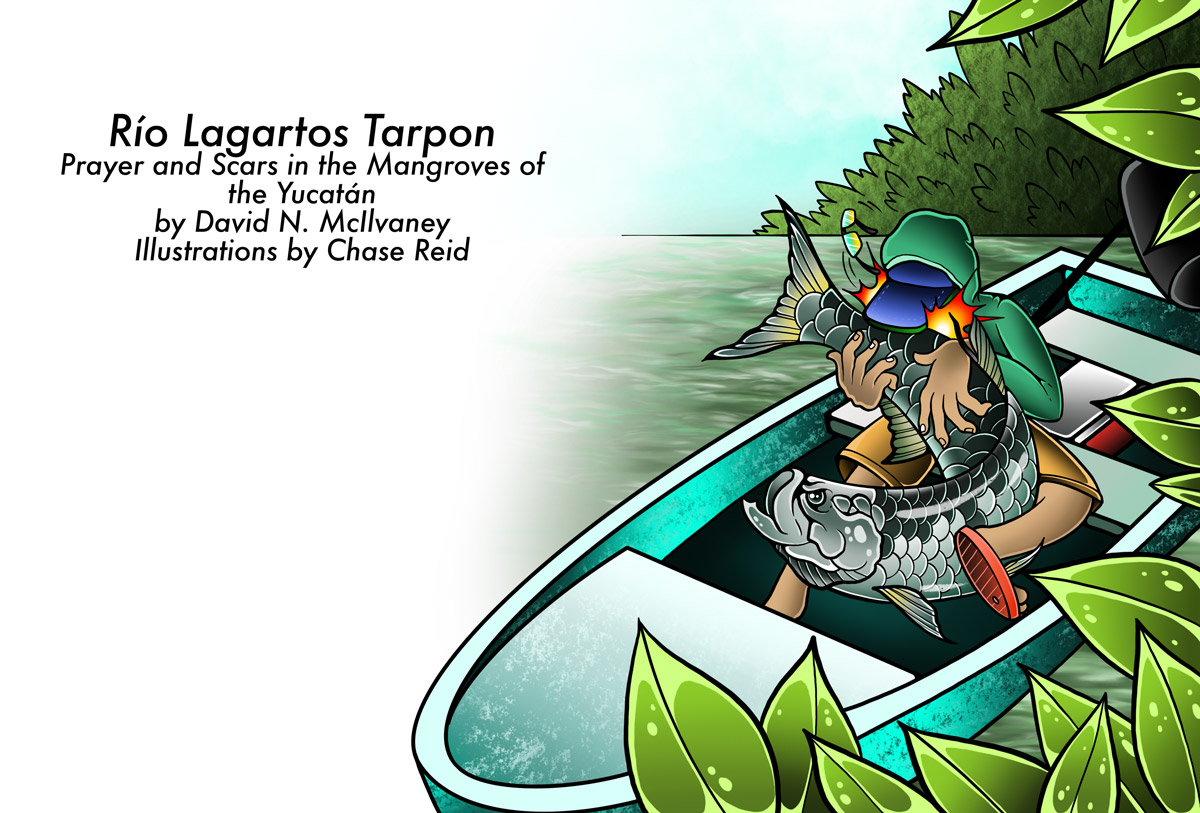by David N. McIlvaney
Fishing boats are fishing boats. Some differences in beam and length, draw and height, construction material and means of propulsion, but basically, they take you to the fish. But when it comes to fly fishing, there is a clear-cut difference between a drift boat on a trout river and a tarpon boat in the mangroves. On a tarpon boat, prayer matters—and the scars run much deeper.
We had just slid into the mangroves to a deep hole called “Ensenada,” searching for the first tarpon of the day, when a 5-foot crocodile surfaced beside the boat.
My host, Alex Hernandez, pointed him out and said, “I think that’s the one that bit me last year.” He rolled up his pant leg and showed the scar on his foot. “A client got his fly stuck on a root and I went in to get it, when something grabbed my foot. Fortunately, he was a small one and I managed to get out of the water before any real damage.”
He turned to the back of the boat. “Pechugo, show him your arm.” The guide at the motor pulled off his shirt to reveal a long deep scar that ran along his left arm. “A large crocodile came into the city via the storm sewer, so a few of the men went after it. It got Pechugo before they got it.”
The croc submerged and the water started boiling in the middle of the open area. Tarpon. “Cast! Cast!” As I flicked out a short roll cast, all I could think was: Don’t get hung up on a root.
A tarpon blasted out of the water and shook my fly with such a fury that the line flew up and wrapped around an overhead branch. He hung on this mangrove crucifix, quivering in the light and spraying silver water as the three of us scrambled to pull the boat over to the tree. I reached out across the water and saw the croc surface again. All I could think now was: Don’t fall in. I wasn’t ready for my scar.
When anglers go to the Yucatán in Mexico to fly fish, they usually fly to Cancun and head south, ultimately going to Ascension Bay for the Grand Slam of bonefish, permit, and tarpon. I’ve caught bonefish and don’t have the cast for permit (yet), so tarpon it was. For the best shot at those, you need to hit the mangrove forests that wrap around the northwest side of the Yucatán, from Campeche to Isla Holbox.
There are a few big and well-respected fly fishing outfitters in the area. Alejandro Hernandez owns and operates Campeche Tarpon, while Holbox is home to the well-known Alejandro Vega, aka Mr. Sand Flea. The crocodile and tarpon above were with Alejandro’s son, who was kind enough to offer me a free afternoon of tarpon fishing during the two days I was in Campeche. I knew I was in the right boat when I spotted the “No Bananas” sign stuck to the gunwale beside a plaque declaring that this boat carried HRH Prince Charles on a tour of the area.
But this isn’t their story.
I was in the Yucatán to fish with a guide some 400 kilometers away from Campeche and well west of Holbox. Someone I didn’t know and could barely find any information on. An independent guide unaffiliated with any of the big operations. A guy named Ismael Navarro.
Some things get caught in our heads. I first read about Ismael years ago. Rhett Schober out of Akumal—who was very helpful to me when I DIY’d my first bonefish in Tulum—mentioned him in a small book on fly fishing the Yucatán. But that was it. No website, Instagram, or other online presence. Then, during the early days of COVID, I saw a post from Rhett: Just a little plea to help a great fly fishing buddy in Rio Lagartos. Ismael is not only a great guide, but he is a super kind and generous soul. Please help him out if you can. Health-related travel mandates were especially tough on the small villages, which were cut off from everything but necessary supplies.
Most of my fishing is DIY and happens in off-the-beaten track locations, so when I do use a guide, I gravitate to guys in similar settings. And I have to admit, I was intrigued by a fisherman named Ismael. The name of exiles and outcasts, sure, but with the ear of God. Ismael in Hebrew is God will hear. The Spanish translation is more direct: God listens. I’m not a religious man, but I’m open to the idea that, as there are no atheists in foxholes, there may be none in fishing boats, either.

Río Lagartos (colloquially, River of Crocodiles) is a small fishing village accessible by a single one-lane road. As with much of that coast, the area is afforded government protection in a series of reserves commonly known as “biospheres,” and the village sits in the middle of the 48,000-hectare Río Lagartos Biosphere Reserve, a combination of coastal dunes, mangroves, small deciduous forests, savanna, grasslands, jaguars, crocodiles, birds of every type—and an exceptional baby tarpon nursery.
After months of WhatsApp conversations with Ismael, my wife and I finally rolled into town for a couple of days of fishing. We arranged to meet at the Yuum Ha Hotel, and as we pulled in front, a friendly guy waved from across the street and walked over. I jumped out of the car to shake his hand and we started talking about fishing. It took about five minutes before I realized he wasn’t Ismael. His name was Frank. I thanked Frank for his time and walked to the hotel to find Ismael waiting. How do you tell if you’re with a smart guide before you get to the water? He makes sure your wife has a great lunch then tells her a stupid joke that makes her laugh.
Half or a quarter Maya, Ismael stood—and I’m being generous here—5-foot something, with the something being pretty close to zero. But in that tight frame, he packed a lot of big and generous soul. We felt like old friends as Ismael took us around to get groceries, beer, and fresh fish from a friend of his, and then he pointed out the direction of our rental house. He would meet me at 7 a.m. on the beach in front of our place—a much shorter trip for both of us.
Forty minutes later, we pulled up in front of our house; as we unloaded, a small gray fox crossed our path. I took this as good sign. The Celts believed the fox was a spirit animal and would guide you on your journey. But then I recalled that it was the journey to the afterlife.
The wind had picked up in the morning and the waves were a good meter high when I saw the blue-green fiberglass panga round the point and come in parallel to the shore, just outside the breaking water. As the boat passed, it swung a hard 90 degrees and came in straight, slicing through the surf to the beach.
Ismael hopped out and took my rods and gear as I clambered in and introduced myself to the guy in the back of the boat manning the motor: Carlos Sansores, 68 years old, sun-worn and wiry, that no-nonsense competence that all fishermen seem to possess. No crocodile scars that I could see.
We pushed off and headed back toward the protected lagoons of the village. The great thing about Río Lagartos is that you are fishing just minutes from the center of town. I never asked, but I’m sure there are a few “pet” tarpon that hang around the dock.
On the way, I mentioned the fox, thinking Ismael might have some Maya insight. “A grey fox is good, man. Or bad. Neutral. Yucatán is going to let you decide.”
Saltwater guides can be tough. I haven’t fished with many, but my first bonefish guide put a deep mark in my psyche with his exasperated, “There, they’re right there!” and “Oh, you blew that cast.” What should have been a good day of fishing and camaraderie quickly turned into me just running out the day. Then there was the guide who drove around in the boat for an hour, “looking for fish,” until he dropped anchor in the middle of a bay. “This should be a good spot.” He pulled out his spinning rod and started casting for his dinner. The bottom was 30 feet down, and I had a floating line set up for bonefish.
But at the same time, I appreciate the hard work involved in getting on fish and the fact that some clients can be total dickheads—overestimating their skills, bringing unrealistic expectations, and treating the guy working his ass off for him like shit. Or they’re real sweet and then drop the bullshit line about not being too concerned with catching fish and “just want to go fishing.” Let’s see how you feel about that at the end of a skunked day.
But I had met and worked with more good guides than not. Far more, in fact. The guys who go that extra distance to get you to the fish. The guys who understand that if we agree to bring together our expectations, mutual skills and desires, and work together, we are going to have a good day. It all comes down to the first fish. Successful guide/client teams are laser-focused on getting that first fish. Jokes are left ashore, small talk is cursory, and the prep in the boat is paramount.
Within minutes, we passed the breakwater and were in the relatively calm lagoon. I tied on a Puglisi Peanut Butter and Ismael tested it by catching the hook on the seat edge and pulling. Satisfied, he said, “Now we look.”
“What are we looking for?” Even though I had hooked a tarpon once before while fishing for bonefish, I had no idea how I did it.
“Silver flashes on the water. Rolling tarpon.”
Tarpon school, or just like one another’s company, and they take in air to supplement oxygen levels. It’s what allows them to live in brackish water with low dissolved oxygen levels. This means that tarpon will gulp air and look as if they are rolling at the surface.
Ismael jumped up to the casting platform as we slowly motored across the flat. I searched the sides looking for any disturbance on the surface when a shift in the wind carried the prayer back to me. Maybe the extra height of the platform didn’t just give him a viewing advantage; it also raised him to be that much closer to heaven. The prayer was low and under his breath as he scanned the water. My religious Spanish is pretty awful and much worse than my fishing Spanish, so I’m going to interpret badly, but here goes: “It is Sábado. Please let David catch a sábalo.” He repeated the prayer over and over as we crisscrossed the water until we spotted a reflective cut in the water about 50 meters away and Carlos turned the boat to position us upwind and poled in.
I pulled off my shoes as Ismael washed down the casting platform to prevent my line from picking up any debris. Then he walked me through his prep list: “Stand here. Point out 11 o’clock—good. Not too many false casts, but if I say “drop,” you drop. Strip like this. Set hard three times. Bow to the king.” I’ll add prayer to the list. And hope God is listening.
My first cast landed at the leading edge of the group of tarpon and we watched as a good-sized fish turned and followed. A moment later, a glint of silver and the living tug. “Set!” I yanked back on my line hand and felt the hook dig it. “Again! Again!”
Another two hard jerks and the fish was on. He let me know by slicing through the water and exploding out. There’s something humbling about being in the open water with a good-sized fish on the line. I’ve caught big trout on a wild stream, and standing on land, albeit under the water, I am rooted and powerful. I command a stream. And the trout knows he really doesn’t have anywhere to go. But in a tiny boat on the vast ocean under a seamless sky, I had no supremacy. The word I’m looking for is insignificant. Despite the gear of boat, rod, and hook, the fish is going to go anywhere he damn well pleases. The tarpon took air again, and I got out of my head and dropped the rod until I felt the fish re-engage. Three more jumps and it began to tire. I have no frame of reference for what constitutes large or small in a baby tarpon. I’m just going to say that it was huge. Ismael unhooked the fish and let it slip back in the water.
First fish to hand, we relaxed and circled them for the next hour. I must have hooked 15 and landed 10. Lost a couple of flies to what I was told were barracudas.
The tarpon eventually moved on, and so did we. We found smaller groups and chased them. Or didn’t. During a slow time, Ismael took the opportunity to work on my double haul (tippet isn’t the only weak link.) He had me skim my back cast along the water’s surface then use the wind to push my forward cast. Nothing new about a Belgian cast, but it’s a technique I never needed on a trout stream when a low roll cast will work. He also tightened my timing and backcast feed. The 8-weight Winston came alive, and I gained an extra 5 meters. Good guides give you something that will help you catch fish in their boat; great guides make you a better angler.

We fished out the day, splitting our time between the open lagoon and the edge of the mangroves, until the boat dropped me off on my beach in the late afternoon. I walked up to the house for a beer and a cigar—and to reflect. My hands were tingling. We know what muscle memory is—repeating an action over and over until it becomes so ingrained in your body that the action becomes second nature. You don’t think about driving; you just drive. The same could be said about my new double haul. But there’s another type of memory that lives in the muscles: the phantom existence of an experience. As I sat on the deck and looked out over the sun setting on the ocean, I could feel the rod handle come alive in my right hand as my left tensed with the hard strain of a strip-set and a racing tarpon. I relived that electric connection between angler and fish as I fought those tarpon again in my mind. I think I even bowed a few times. My wife popped her head out to ask if I was okay. I was. Very much so.
Second days on the water are either not as good as the first or better, which is to say they are always different.
With weather threatening the next morning, we decided to skip the flats and go deep into the mangroves, where I quickly lost track of the sights and sounds of ocean and sky. The boat slid through an opening in the tight branches and we came out to a pool where we could see tarpon cruising underneath. Big tarpon. There was just enough room to throw up a high back cast over the tops of the trees, then let it drop and drive it forward. It was a sloppy, stupid cast, but it received an approving nod from Carlos. Not the fish, though. They ignored every fly. I would literally drag a fly in front of a fish—a twitch to the right and I could have snagged one—and it barely elicited a glance.
Ismael was in the back of the boat quietly praying again, as I sat up front watching the water and cutting up a mango with a small knife when I heard a tremendous crash behind me. I thought for certain that a jaguar had attacked, and I whirled with the fruit knife at the ready. A meter-long tarpon had leapt out of the water and landed in Ismael’s lap. He was fighting it off as it flailed around, its tail slapping him in the face. You want to test your mettle? Go a few rounds with a pissed-off tarpon in a boat. Ismael managed to get both hands underneath and heaved it over the side. We caught our breath and started laughing as another fish slammed into the side of the boat. Then another. Tarpon were attacking the boat.
Sábalo! The terror from the mangroves!
Just as quickly, they stopped, and we collectively decided to get lunch.
Ten minutes later, we were at the docks. The tide had gone out, so we pulled up on a newly exposed “beach” in the middle of the lagoon and ate while watching shorebirds work the wet sand.
I asked Ismael about his background. He is 44 and was born about 40 kilometers from Río Lagartos. Though he’s a fishing guide, he was a professional bird guide for an ornithologist for a time. One day, he was approached on the Río docks by the ornithologist looking for a turquoise-browed motmot. Ismael had no idea what the hell he was talking about, but he was game enough to try and find one. Within two days, the scientist made Ismael his assistant, and they began a multi-year professional relationship that took them all over the Yucatán in search of birds. I asked Ismael why he didn’t work for one of the big outfitters. Our feet were resting on edge of the boat as we enjoyed a beer. He smiled and pointed out a flamboyance of flamingos gliding overhead, pale scarlet birds against an azurite blue like a ‘50s postcard.
“Would you leave?”
My eyes drifted down to the band of dark green trees edging the deeper turquoise of the water. And a flash of silver. Ismael saw my face. He tossed his empty in the cooler. “C’mon, let’s get you another fish.”
The next day, I started to pack for our departure. Grabbing some loose flies, I felt a sharp pain when a hook point pierced my thumb. Backing the hook out slowly, a drop of blood appeared at the wound and I instinctively put my thumb in my mouth. When I looked up, the fox was sitting on a small dune staring at me. My guide on the journey to the afterlife.
It’s just a small wound, fox.
We held eyes, then he turned and disappeared into the brush. In the end, the Yucatán let me decide and gave me my scar, which earned me the right to come back. When I do, I have guides waiting.
Bio: David. N. McIlvaney is an outdoor writer who splits his time between New York City and a tiny Catskill camp, where he hews wood and draws water. His fishing writing has been published in The Flyfish Journal, Hatch Magazine, Gotham Canoe and The Wading List. This is his first appearance in Tail Fly Fishing. Find him on Instagram: @the_real_dnm. Ismael Navarro can be contacted by WhatsApp voice call at +52 986 108 26 48 or by email at riolaga@hotmail.com.
SUBSCRIBE TO TAIL FLY FISHING MAGAZINE
 MORE GREAT SALTWATER FLY FISHING READS…
MORE GREAT SALTWATER FLY FISHING READS…


